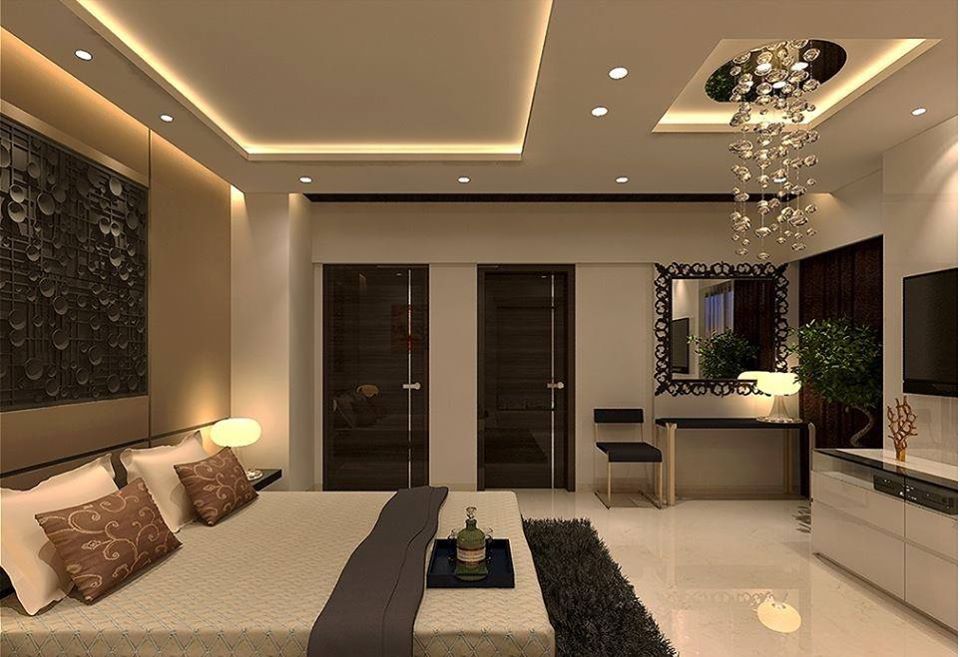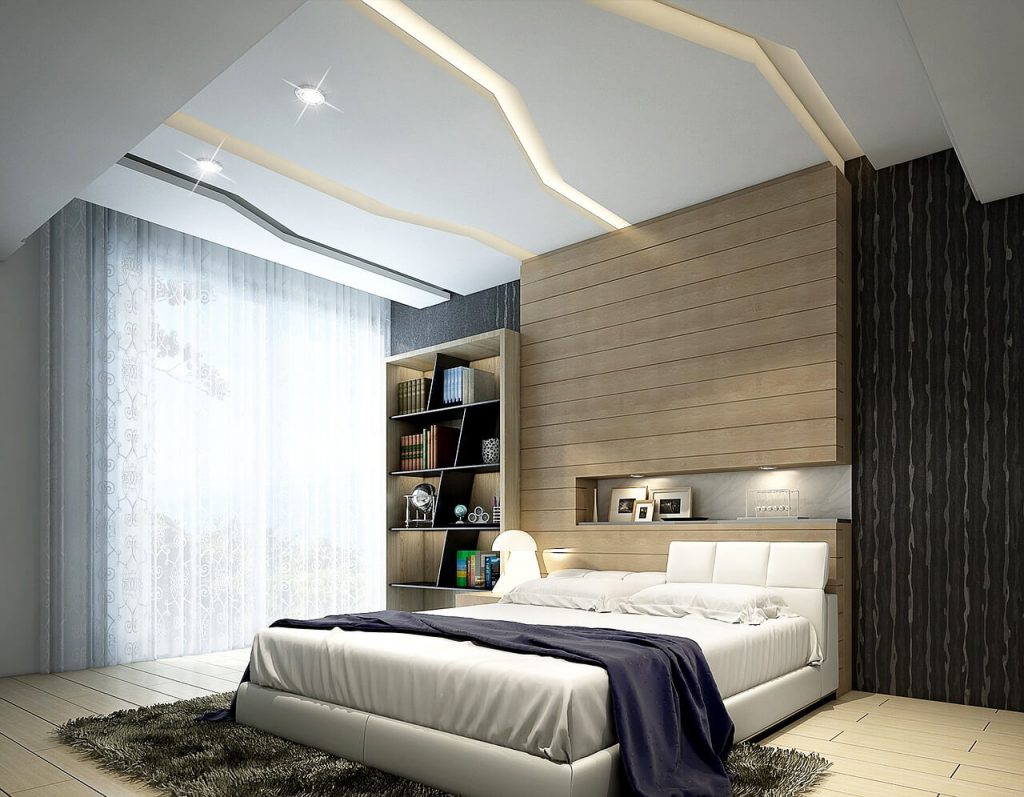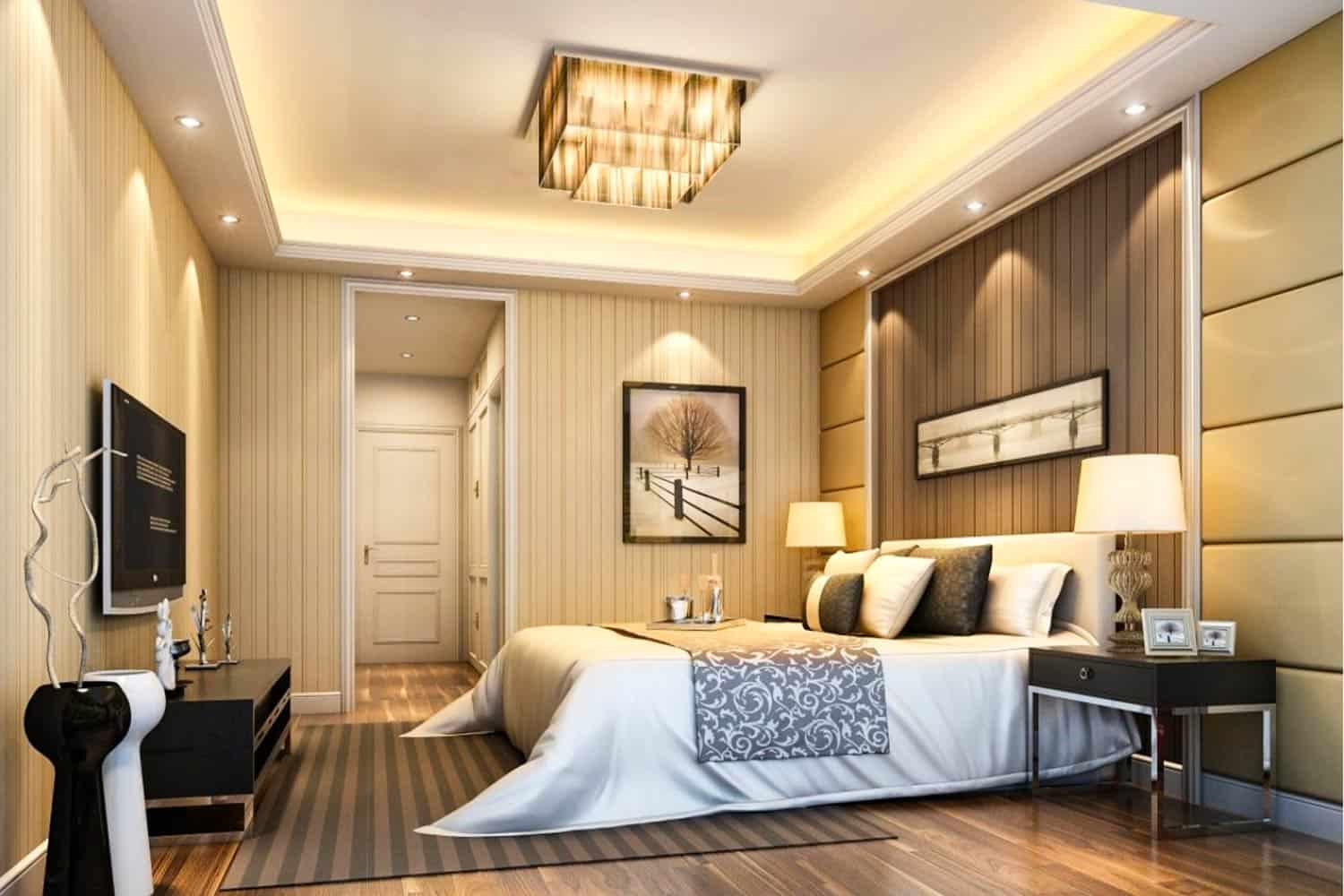
Bedroom ceiling design encompasses the creative and functional elements that adorn the ceiling of a bedroom space. It plays a significant role in shaping the overall ambiance, aesthetics, and functionality of the room.
Ceiling design in bedrooms extends beyond mere aesthetics; it offers practical advantages as well. From intricate moldings and cornices to suspended panels and lighting fixtures, bedroom ceiling designs can enhance acoustics, regulate temperature, and provide ambient lighting. Historically, ornate ceiling designs were a hallmark of grandeur, as seen in the elaborate plasterwork and frescoes of palaces and stately homes.
Bedroom Ceiling Design
Bedroom ceiling design encompasses a wide range of elements that contribute to the overall aesthetic and functionality of the space. Key aspects to consider include:
- Architectural details: Moldings, cornices, beams, and other architectural features can add depth and character to the ceiling.
- Lighting: Recessed lighting, pendant lights, and chandeliers provide both ambient and task lighting, while creating a desired ambiance.
- Color: The color of the ceiling can impact the overall mood of the room, from light and airy to dark and dramatic.
- Texture: Smooth, textured, or coffered ceilings add visual interest and can help absorb sound.
- Height: The height of the ceiling can affect the perceived spaciousness of the room.
- Shape: Vaulted, sloped, or tray ceilings can create a unique focal point and enhance the architectural interest.
- Materials: From traditional plaster to modern metal and wood, the choice of ceiling material can influence the overall style and durability.
- Function: Acoustic panels and radiant heating systems can be integrated into the ceiling design to improve comfort and functionality.
These key aspects are interconnected and should be considered holistically when designing a bedroom ceiling. For example, the height of the ceiling may influence the choice of lighting fixtures, while the color of the ceiling can complement or contrast with the wall finishes. By carefully considering each aspect, designers can create a bedroom ceiling design that is both visually appealing and functional.

Architectural details
Ceiling designs can be enhanced with architectural details like moldings, cornices, beams, and other features that add visual appeal and depth to a bedroom’s interior.
- Moldings: These decorative elements can frame the ceiling, creating a sense of division between the ceiling and walls. They can also be used to accentuate specific areas, such as the area above the bed or a fireplace.
- Cornices: Similar to moldings, cornices are horizontal decorative elements that can be used to create a more formal or traditional look in a bedroom. They are often more elaborate than moldings and can feature intricate designs.
- Beams: Exposed beams can add a rustic or industrial touch to a bedroom. They can be made from wood, metal, or other materials, and can be used to create a variety of looks, from traditional to contemporary.
- Other architectural features: In addition to moldings, cornices, and beams, other architectural features that can be used to enhance a bedroom ceiling include domes, vaults, and coffers. These features can add a sense of grandeur and sophistication to a space.
By incorporating architectural details into a bedroom ceiling design, homeowners can create a space that is both stylish and inviting. These elements can add depth and character to a room, and can be used to create a variety of looks, from traditional to contemporary.

Lighting
Lighting plays a crucial role in bedroom ceiling design, as it can set the mood and atmosphere of the space. Different types of lighting can be used to create different effects, from bright and airy to dim and romantic.
Recessed lighting is a popular choice for bedroom ceilings, as it provides general, ambient lighting without taking up too much space. Pendant lights and chandeliers can be used to add task lighting to specific areas of the room, such as the bed or a reading nook. They can also be used to create a more decorative look.
When choosing lighting for a bedroom ceiling, it is important to consider the overall design of the room. The style of the lighting should complement the style of the furniture and dcor. It is also important to consider the function of the room. If the bedroom is primarily used for sleeping, then you may want to choose softer, more subdued lighting. If the bedroom is also used for reading or working, then you may want to choose brighter lighting.
By carefully considering the type of lighting used, homeowners can create a bedroom ceiling design that is both stylish and functional. Lighting can be used to create a variety of looks, from traditional to contemporary, and can help to set the mood and atmosphere of the space.

Color
Color plays a significant role in bedroom ceiling design, as it can greatly impact the overall mood and atmosphere of the space. Different colors can evoke different emotions and create different effects, from light and airy to dark and dramatic.
For example, light colors such as white, cream, and light blue can make a bedroom feel more spacious and airy. These colors reflect light, which helps to brighten the room and make it feel more inviting. Darker colors, such as black, navy, and deep green, can create a more intimate and cozy atmosphere. These colors absorb light, which can make the room feel smaller and more enclosed.
The color of the ceiling can also be used to create a focal point or to draw attention to a particular area of the room. For example, a dark-colored ceiling can be used to create a dramatic effect above the bed, while a light-colored ceiling can be used to brighten up a dark corner.
When choosing a color for the bedroom ceiling, it is important to consider the overall design of the room, as well as the function of the space. If the bedroom is primarily used for sleeping, then you may want to choose a calming color, such as blue or green. If the bedroom is also used for reading or working, then you may want to choose a brighter color, such as white or yellow.
By carefully considering the color of the ceiling, homeowners can create a bedroom ceiling design that is both stylish and functional. Color can be used to create a variety of looks, from traditional to contemporary, and can help to set the mood and atmosphere of the space.

Texture
Texture plays an important role in bedroom ceiling design, as it can affect both the visual appearance and the acoustic properties of the space. Different textures can create different effects, from smooth and sleek to rough and rustic.
Smooth ceilings are a popular choice for bedrooms, as they create a clean and modern look. They are also easy to clean and maintain. However, smooth ceilings can sometimes appear flat and uninteresting. To add visual interest, homeowners can incorporate textured elements, such as crown molding or beams.
Textured ceilings can add depth and character to a bedroom. They can also be used to hide imperfections in the ceiling. However, textured ceilings can be more difficult to clean than smooth ceilings. They can also trap dust and allergens.
Coffered ceilings are a type of textured ceiling that features recessed panels. Coffered ceilings can add a sense of grandeur to a bedroom. They can also help to improve the acoustics of the space by absorbing sound.
When choosing a texture for the bedroom ceiling, it is important to consider the overall design of the room, as well as the function of the space. If the bedroom is primarily used for sleeping, then you may want to choose a smooth or textured ceiling. If the bedroom is also used for reading or working, then you may want to choose a coffered ceiling to help absorb sound.
By carefully considering the texture of the ceiling, homeowners can create a bedroom ceiling design that is both stylish and functional. Texture can be used to create a variety of looks, from traditional to contemporary, and can help to set the mood and atmosphere of the space.

Height
The height of a bedroom ceiling is an important factor to consider when designing the space. A higher ceiling can make a room feel more spacious and airy, while a lower ceiling can make a room feel more cozy and intimate. The perceived spaciousness of a room is also affected by the size of the windows and the amount of natural light that enters the space. A room with large windows and plenty of natural light will feel more spacious than a room with small windows and less natural light.
There are a number of ways to make a bedroom ceiling appear taller. One way is to use vertical stripes on the walls. Vertical stripes can draw the eye upward, making the ceiling appear taller. Another way to make a ceiling appear taller is to use light colors on the ceiling. Light colors reflect light, which can make a room feel more spacious. Finally, using recessed lighting can also help to make a ceiling appear taller. Recessed lighting is installed in the ceiling, which means that it does not take up any vertical space.
The height of the ceiling is an important factor to consider when designing a bedroom. By carefully considering the height of the ceiling, homeowners can create a space that is both stylish and functional.

Shape
The shape of a bedroom ceiling can have a significant impact on the overall design of the space. Vaulted, sloped, and tray ceilings are all popular choices for bedrooms, as they can add a touch of drama and elegance to the room. These types of ceilings can also be used to create a focal point or to draw attention to a particular area of the room.
- Vaulted ceilings: Vaulted ceilings are ceilings that are higher in the center than they are at the sides. This type of ceiling can make a room feel more spacious and grand. Vaulted ceilings are often used in master bedrooms or other large bedrooms.
Sloped ceilings: Sloped ceilings are ceilings that are slanted. This type of ceiling can add a touch of coziness to a bedroom. Sloped ceilings are often used in attic bedrooms or other bedrooms with a sloped roof.
Tray ceilings: Tray ceilings are ceilings that have a recessed area in the center. This type of ceiling can add a touch of sophistication to a bedroom. Tray ceilings are often used in formal bedrooms or other bedrooms with a high ceiling.
When choosing a shape for your bedroom ceiling, it is important to consider the overall design of the room. You should also consider the function of the room. If you want to create a more spacious and grand bedroom, then you may want to choose a vaulted ceiling. If you want to create a more cozy and intimate bedroom, then you may want to choose a sloped ceiling. And if you want to create a more sophisticated and formal bedroom, then you may want to choose a tray ceiling.

Materials
The choice of ceiling material plays a vital role in shaping the aesthetics and functionality of a bedroom’s design. Different materials possess unique properties that can enhance the overall ambiance and meet specific practical requirements.
- Traditional Plaster:
Plaster, a timeless material, offers a smooth and elegant finish. Its versatility allows for intricate moldings and cornices, adding a touch of classic sophistication to the ceiling. Furthermore, plaster’s natural soundproofing qualities contribute to a tranquil sleeping environment.
- Modern Metal:
Metal ceilings, crafted from materials like aluminum or tin, introduce a contemporary and industrial aesthetic. Their sleek surfaces reflect light, creating a spacious and airy feel. Metal’s durability and resistance to moisture make it a suitable choice for bedrooms with high humidity levels.
- Warm Wood:
Wooden ceilings exude a sense of warmth and natural elegance. The rich textures and grains of wood species like oak, mahogany, or pine bring depth and character to the space. Wood’s insulating properties help regulate temperature, contributing to a cozy and inviting atmosphere.
- Acoustic Panels:
For bedrooms that prioritize sound absorption, acoustic panels are an effective solution. Made from materials like fiberglass or fabric, these panels reduce noise levels, creating a peaceful and serene sleeping environment. Their availability in various colors and textures allows for seamless integration with the overall design scheme.
The choice of ceiling material in bedroom design extends beyond aesthetics; it also impacts durability, acoustics, and the overall ambiance of the space. By carefully considering the material’s properties, designers can create a bedroom ceiling that is both visually appealing and functionally tailored to the desired experience.
Function
Ceiling design in bedrooms goes beyond aesthetics. It plays a crucial role in enhancing comfort and functionality. Two key elements that contribute to this are acoustic panels and radiant heating systems.
Acoustic panels, integrated into the ceiling, effectively absorb sound, mitigating noise levels and creating a tranquil sleeping environment. This is particularly beneficial for bedrooms in urban areas or near busy streets. The panels can be seamlessly incorporated into the ceiling’s design, ensuring both aesthetic appeal and acoustic comfort.
Radiant heating systems, concealed within the ceiling, provide an efficient and comfortable way to warm a bedroom. Heat is evenly distributed throughout the room, resulting in a cozy and inviting atmosphere. Since the system is embedded in the ceiling, it eliminates the need for bulky radiators or baseboard heaters, maximizing space and preserving the room’s aesthetics.
The integration of acoustic panels and radiant heating systems into the ceiling design underscores the importance of functionality in bedroom design. By prioritizing comfort and well-being, these elements contribute to a restful and restorative sleep environment, essential for overall health and productivity.
FAQs
This section addresses frequently asked questions about bedroom ceiling design to provide comprehensive information and dispel common misconceptions.
Question 1: What is the purpose of ceiling design in bedrooms?
Ceiling design in bedrooms serves both functional and aesthetic purposes. It can enhance acoustics, regulate temperature, and provide ambient lighting, while also contributing to the overall ambiance and style of the room.
Question 2: How does ceiling height affect bedroom design?
Ceiling height significantly impacts the perceived spaciousness of a bedroom. Higher ceilings create an airy and expansive feel, while lower ceilings can foster a more cozy and intimate atmosphere. It’s important to consider the size and proportions of the room when selecting a ceiling height and design.
Question 3: What are some popular ceiling materials for bedrooms?
Common ceiling materials for bedrooms include drywall, plaster, wood, and metal. Drywall provides a smooth and versatile surface, while plaster offers a more traditional and textured look. Wood adds warmth and character, and metal brings a contemporary and industrial aesthetic. The choice of material depends on the desired style and functional requirements.
Question 4: How can I integrate lighting into my bedroom ceiling design?
Lighting plays a crucial role in bedroom ceiling design. Recessed lighting provides general illumination, while pendant lights and chandeliers add task lighting and decorative accents. Consider using dimmers to adjust the lighting intensity and create different atmospheres.
Question 5: What are some unique ceiling design ideas for bedrooms?
Unique ceiling design ideas include incorporating architectural details like moldings and beams, adding texture with coffered or textured ceilings, and using color to create a focal point or enhance the room’s ambiance.
Question 6: How can I make my bedroom ceiling look taller?
To make a bedroom ceiling appear taller, use vertical stripes on the walls or paint the ceiling a light color. Install recessed lighting and avoid bulky light fixtures that hang low. Additionally, consider adding a skylight or installing floor-to-ceiling windows to bring in natural light and create an illusion of height.
These FAQs provide insights into various aspects of bedroom ceiling design, empowering homeowners and designers to make informed decisions to create comfortable, stylish, and functional spaces.
